人教版(2019)必修第二册Unit 1 Cultural Heritage Reading and Thinking课件(共22张PPT)
文档属性
| 名称 | 人教版(2019)必修第二册Unit 1 Cultural Heritage Reading and Thinking课件(共22张PPT) | 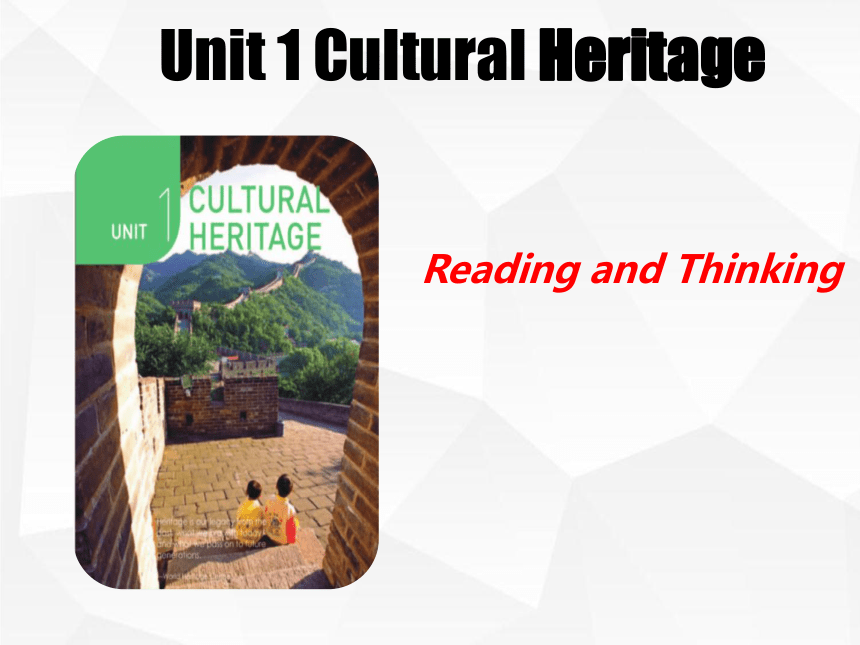 | |
| 格式 | pptx | ||
| 文件大小 | 14.4MB | ||
| 资源类型 | 教案 | ||
| 版本资源 | 人教版(2019) | ||
| 科目 | 英语 | ||
| 更新时间 | 2025-03-02 15:52:58 | ||
图片预览


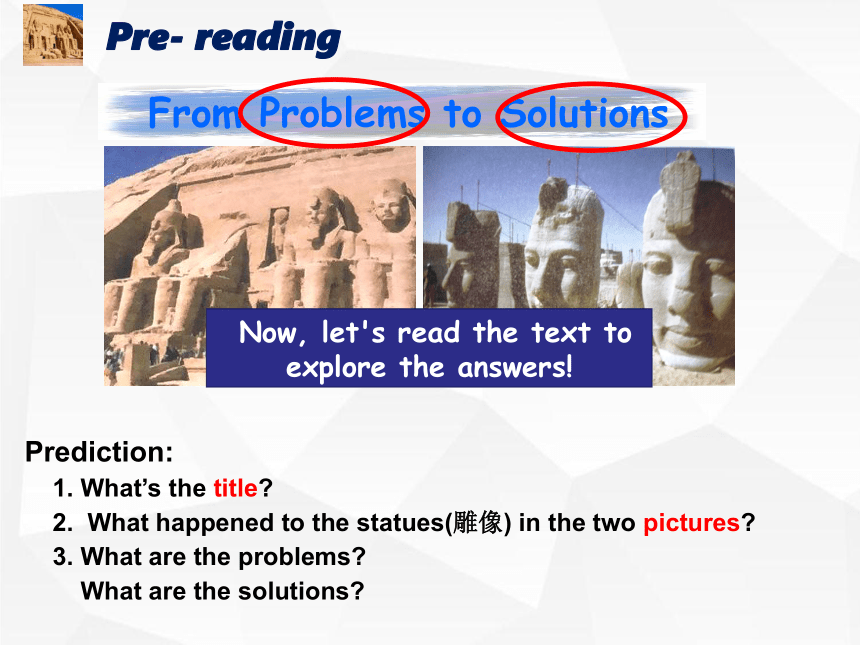
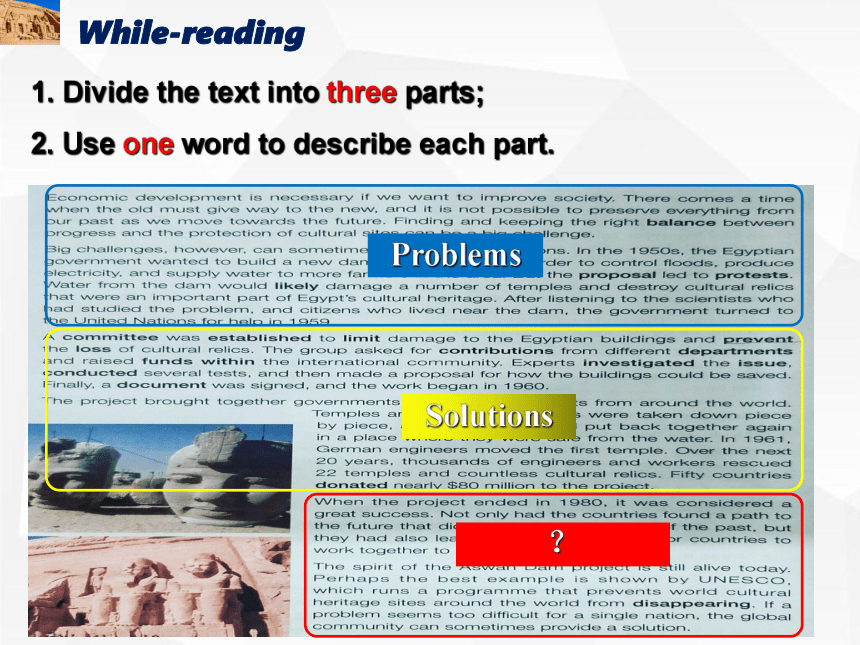
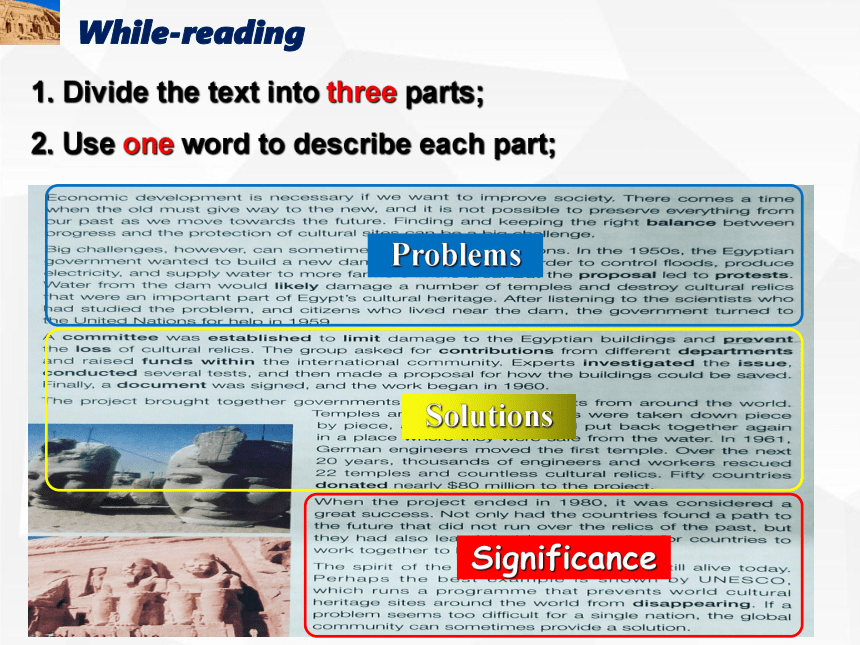
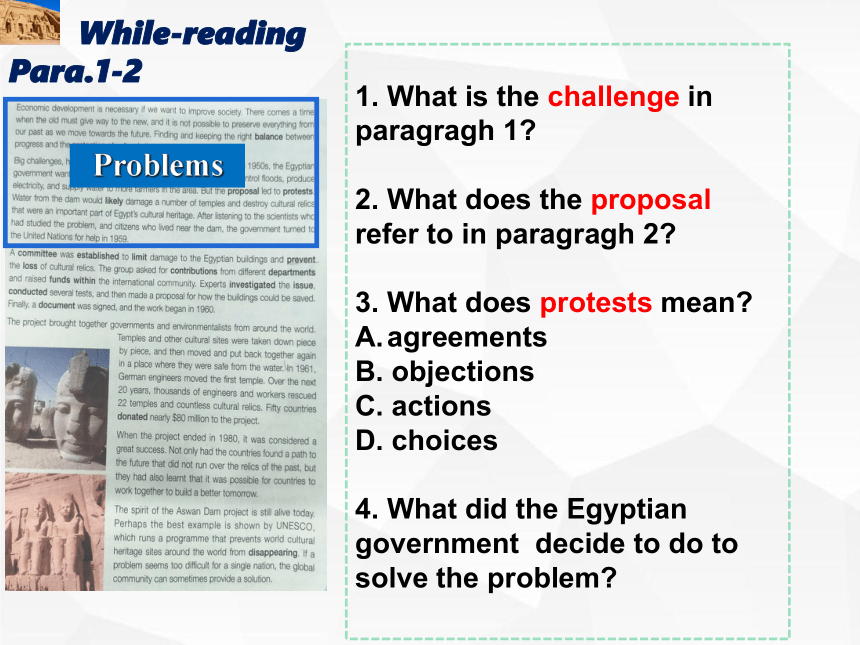
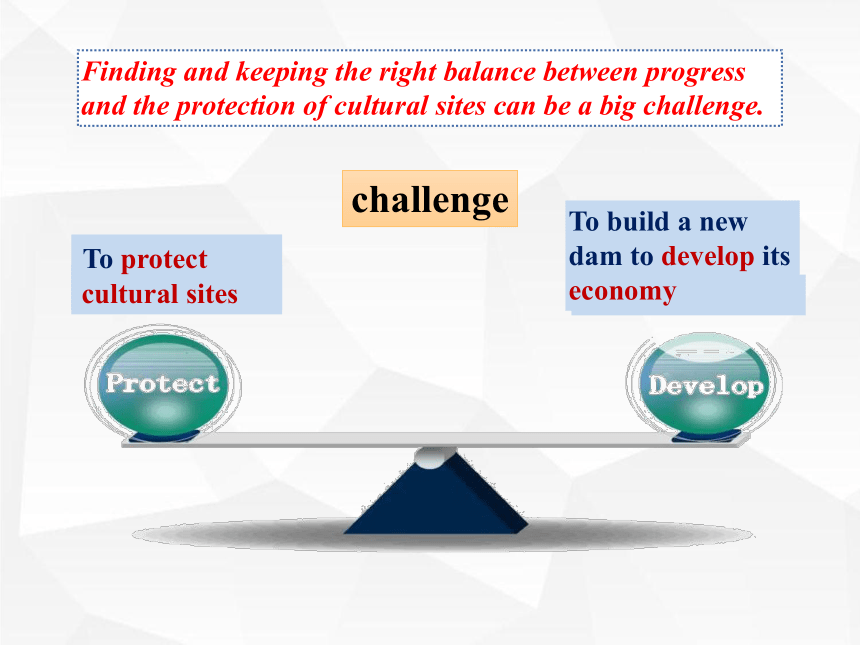
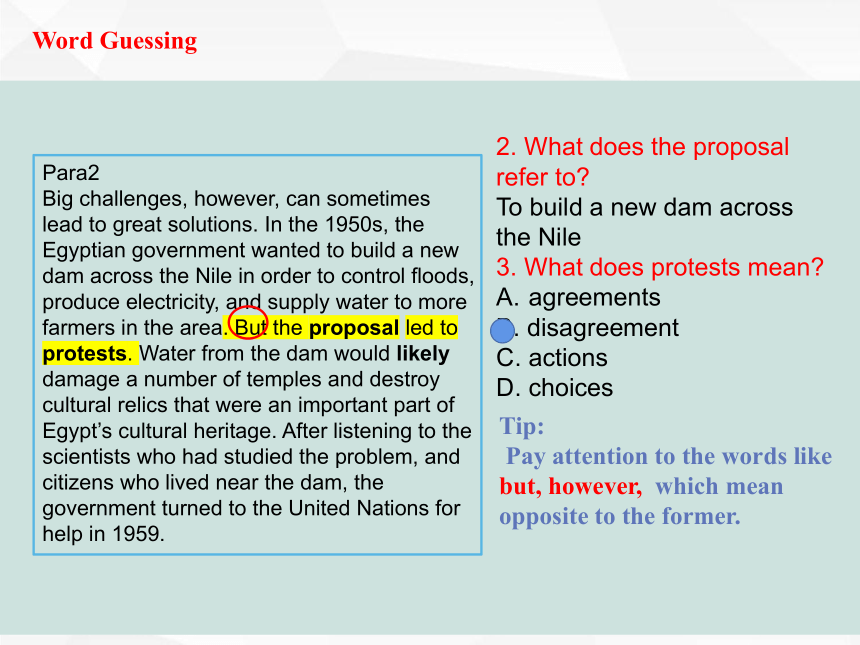
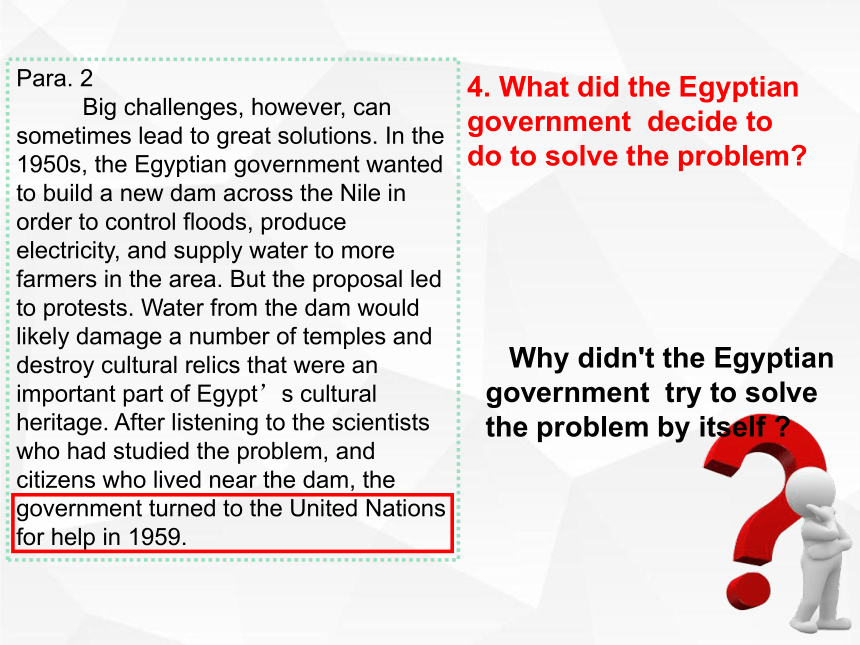
文档简介
(共22张PPT)
Unit 1 Cultural Heritage
Reading and Thinking
1. Do you know the name of the temple
2. What do you know about it
Free talk
Abu Simbel Temple
It was built 3000 years ago.
temple
Prediction:
1. What’s the title
2. What happened to the statues(雕像) in the two pictures
3. What are the problems
What are the solutions
From Problems to Solutions
Now, let's read the text to explore the answers!
Pre- reading
Problems
Solutions
?
1. Divide the text into three parts;
2. Use one word to describe each part.
While-reading
Problems
Solutions
1. Divide the text into three parts;
2. Use one word to describe each part;
While-reading
Significance
1. What is the challenge in paragragh 1
2. What does the proposal refer to in paragragh 2
3. What does protests mean
agreements
B. objections
C. actions
D. choices
4. What did the Egyptian government decide to do to solve the problem
While-reading
Problems
Para.1-2
challenge
Finding and keeping the right balance between progress and the protection of cultural sites can be a big challenge.
To protect
cultural sites
To build a new dam to develop its economy
Word Guessing
Para2
Big challenges, however, can sometimes lead to great solutions. In the 1950s, the Egyptian government wanted to build a new dam across the Nile in order to control floods, produce electricity, and supply water to more farmers in the area. But the proposal led to protests. Water from the dam would likely damage a number of temples and destroy cultural relics that were an important part of Egypt’s cultural heritage. After listening to the scientists who had studied the problem, and citizens who lived near the dam, the government turned to the United Nations for help in 1959.
2. What does the proposal refer to
To build a new dam across the Nile
3. What does protests mean
agreements
B. disagreement
C. actions
D. choices
Tip:
Pay attention to the words like but, however, which mean opposite to the former.
4. What did the Egyptian government decide to do to solve the problem
Para. 2
Big challenges, however, can sometimes lead to great solutions. In the 1950s, the Egyptian government wanted to build a new dam across the Nile in order to control floods, produce electricity, and supply water to more farmers in the area. But the proposal led to protests. Water from the dam would likely damage a number of temples and destroy cultural relics that were an important part of Egypt’s cultural heritage. After listening to the scientists who had studied the problem, and citizens who lived near the dam, the government turned to the United Nations for help in 1959.
Why didn't the Egyptian government try to solve the problem by itself
solutions
While-reading
1. What help did the UN offer
2. Finish the timetable
Para. 3-4
What help did the UN offer
A committee was established to limit damage to the Egyptian buildings and prevent the loss of cultural relics. The group asked for contributions from different departments and raised funds within the international community. Experts investigated the issue, conducted several tests, and then made a proposal for how the buildings could be saved. Finally, a document was signed, and the work began in 1960.
cooperation
1959
1961-1980
1980
The project started.
The government asked the UN for help.
The project was completed.
2. Finish the timeline.
1960
Reading Para 3-4
The project brought together governments and environmentalists from around the world. Temples and other cultural sites were taken down piece by piece, and then moved and put back together again in a place where they were safe from the water. In 1961, German engineers moved the first temple. Over the next 20 years, thousands of engineers and workers rescued 22 temples and countless cultural relics.
Reading
How did they save the temples and other cultural sites
1959
1961-1980
1980
The project started.
The government asked the UN for help.
The first temple was moved.
The temples and cultural relics were being rescued.
The project was completed.
2. Finish the timeline.
1960
1961
Significance
While-reading(Activity 3. 3)
Para. 5-6
1. Why is the project a great success
2. What is the spirit of the Aswan Dam project
work together to
build a better tomorrow
show team spirit when solving difficult problems
Protect cultural heritage.
Global community can make a difference.
Post-reading
Summary Fill in the blanks
Post-reading
Problems
Solutions
Significance
Summary
hard to keep balance
build a new dam vs. damage temples & cultural heritage
turn to UN for help
cooperate with other countries
take down piece by piece, then move and put back together
success
team spirit
global community
Because Egyptian history and relics are world-famous and are highly valued.
It belongs to Egypt. It belongs to the world.
Thinking Discuss in groups
Why do you think so many countries contributed funds and offered help to the Egyptian project
Post-reading
Homework
1. Complete Ex.5 on page 5.
2. Watch a video clip about the Mogao Caves and find the problems that Magao Caves are faced with and give your solutions.
Thank you!
Unit 1 Cultural Heritage
Reading and Thinking
1. Do you know the name of the temple
2. What do you know about it
Free talk
Abu Simbel Temple
It was built 3000 years ago.
temple
Prediction:
1. What’s the title
2. What happened to the statues(雕像) in the two pictures
3. What are the problems
What are the solutions
From Problems to Solutions
Now, let's read the text to explore the answers!
Pre- reading
Problems
Solutions
?
1. Divide the text into three parts;
2. Use one word to describe each part.
While-reading
Problems
Solutions
1. Divide the text into three parts;
2. Use one word to describe each part;
While-reading
Significance
1. What is the challenge in paragragh 1
2. What does the proposal refer to in paragragh 2
3. What does protests mean
agreements
B. objections
C. actions
D. choices
4. What did the Egyptian government decide to do to solve the problem
While-reading
Problems
Para.1-2
challenge
Finding and keeping the right balance between progress and the protection of cultural sites can be a big challenge.
To protect
cultural sites
To build a new dam to develop its economy
Word Guessing
Para2
Big challenges, however, can sometimes lead to great solutions. In the 1950s, the Egyptian government wanted to build a new dam across the Nile in order to control floods, produce electricity, and supply water to more farmers in the area. But the proposal led to protests. Water from the dam would likely damage a number of temples and destroy cultural relics that were an important part of Egypt’s cultural heritage. After listening to the scientists who had studied the problem, and citizens who lived near the dam, the government turned to the United Nations for help in 1959.
2. What does the proposal refer to
To build a new dam across the Nile
3. What does protests mean
agreements
B. disagreement
C. actions
D. choices
Tip:
Pay attention to the words like but, however, which mean opposite to the former.
4. What did the Egyptian government decide to do to solve the problem
Para. 2
Big challenges, however, can sometimes lead to great solutions. In the 1950s, the Egyptian government wanted to build a new dam across the Nile in order to control floods, produce electricity, and supply water to more farmers in the area. But the proposal led to protests. Water from the dam would likely damage a number of temples and destroy cultural relics that were an important part of Egypt’s cultural heritage. After listening to the scientists who had studied the problem, and citizens who lived near the dam, the government turned to the United Nations for help in 1959.
Why didn't the Egyptian government try to solve the problem by itself
solutions
While-reading
1. What help did the UN offer
2. Finish the timetable
Para. 3-4
What help did the UN offer
A committee was established to limit damage to the Egyptian buildings and prevent the loss of cultural relics. The group asked for contributions from different departments and raised funds within the international community. Experts investigated the issue, conducted several tests, and then made a proposal for how the buildings could be saved. Finally, a document was signed, and the work began in 1960.
cooperation
1959
1961-1980
1980
The project started.
The government asked the UN for help.
The project was completed.
2. Finish the timeline.
1960
Reading Para 3-4
The project brought together governments and environmentalists from around the world. Temples and other cultural sites were taken down piece by piece, and then moved and put back together again in a place where they were safe from the water. In 1961, German engineers moved the first temple. Over the next 20 years, thousands of engineers and workers rescued 22 temples and countless cultural relics.
Reading
How did they save the temples and other cultural sites
1959
1961-1980
1980
The project started.
The government asked the UN for help.
The first temple was moved.
The temples and cultural relics were being rescued.
The project was completed.
2. Finish the timeline.
1960
1961
Significance
While-reading(Activity 3. 3)
Para. 5-6
1. Why is the project a great success
2. What is the spirit of the Aswan Dam project
work together to
build a better tomorrow
show team spirit when solving difficult problems
Protect cultural heritage.
Global community can make a difference.
Post-reading
Summary Fill in the blanks
Post-reading
Problems
Solutions
Significance
Summary
hard to keep balance
build a new dam vs. damage temples & cultural heritage
turn to UN for help
cooperate with other countries
take down piece by piece, then move and put back together
success
team spirit
global community
Because Egyptian history and relics are world-famous and are highly valued.
It belongs to Egypt. It belongs to the world.
Thinking Discuss in groups
Why do you think so many countries contributed funds and offered help to the Egyptian project
Post-reading
Homework
1. Complete Ex.5 on page 5.
2. Watch a video clip about the Mogao Caves and find the problems that Magao Caves are faced with and give your solutions.
Thank you!
